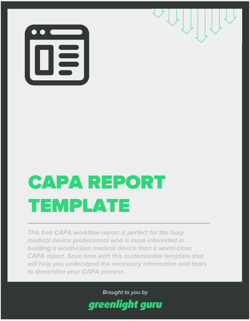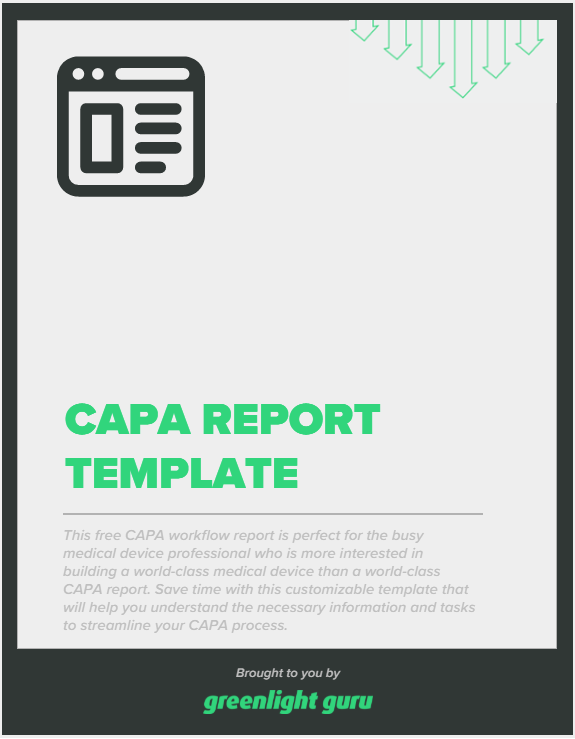
I have a bold opinion: The corrective and preventive action (CAPA) process is the 2nd-most important component of your quality management system (QMS).
(If you want to know what I think is #1, shoot me an email)
As you build medical devices, a well-defined CAPA program provides a framework for quality and effectiveness, whether in product, process, or people. That’s why getting the CAPA quality fundamentals right is so important.
Breakdown of the 5 CAPA quality process steps
Let’s take a look at the five foundational steps to the CAPA quality process.
1. Identify potential CAPA quality cases
CAPA is the heart of your QMS and indicates the overall health of the QMS. So, monitoring the inputs to the CAPA process is essential to ensure you’re promptly identifying any potential quality issues. The FDA agrees, as 21 CFR 820 includes a requirement for manufacturers to have processes to analyze input data.
There are quite a few CAPA inputs that you should be actively monitoring, such as:
-
Non-conforming material report (NCMR)
-
Internal and external audits
-
Management reviews
-
Validation activities
-
Risk analysis
-
Complaints
-
Clinicals
When you’ve spotted a potential CAPA case, the next step is to document it with a CAPA request. These should contain an accurate description of the possible CAPA, a detailed list of its probable sources, any available evidence, and an explanation of how the information was reported.
From there, a quality review board (QRB) - a group consisting of strong cross-functional representation - should review to determine whether a CAPA investigation should or shouldn’t take place.
It’s crucial that you understand what should or shouldn’t trigger a CAPA investigation. Your CAPA process is meant to address systemic quality issues, such as a component that repeatedly fails inspections during manufacturing.
Occasionally, companies get “CAPA-happy” and escalate every one-off event into a CAPA. It may seem like a good way to be diligent, but this approach is reactive and ultimately weakens your CAPA program’s effectiveness.
2. Prepare for investigation with a defined CAPA quality process
As the saying goes, “Those who fail to prepare should prepare to fail,” and while I risk sounding like your high school vice-principal, this is abundantly true in your CAPA program. Once you’ve accepted a case into your CAPA program, the next foundational step is to make sure you are fully ready for the investigation.
It’s always a good idea to formalize the process by assigning the new investigation a unique identification number. This will help you to track and reference the case throughout the CAPA process.
You’ll also also need to finalize your CAPA sources by identifying the parties, processes, procedures, and departments that may be associated with the CAPA. It’s important to be thorough, as any missing information will negatively impact your investigation as the process moves forward.
In terms of your CAPA sources, keep in mind that there are six potential sources for a quality problem:
-
Method
-
Material
-
Machine
-
Manpower
-
Measurement
-
Mother Nature (AKA, environment)
Once you’ve clearly determined the sources, products, and processes involved with the CAPA, this will help you to identify the people you need on the team overseeing the investigation. I strongly advise you to carefully consider who should be involved.
For example, you might need engineering, marketing, manufacturing or regulatory as part of your team. Whatever the case may be, build your CAPA team appropriately for addressing the issues identified.
3. Investigate the root cause of CAPA quality problem
With your data, sources, and team in-place, it’s time to get down to business. Start your investigation by determining what immediate actions are needed for containment. This might mean stopping production, switching to a new parts supplier, or issuing a recall—whatever is needed to prevent the issue from becoming more widespread.
Once the issue has been contained, you can turn your attention to the root cause of the problem. To do so, your investigation should return to the source—the product, processes, and people involved.
When issues arise with a medical device, a root cause analysis offers an opportunity to gain understanding that will help with the current problem and provide insight moving forward.
In addition, 21 CFR 820.100 states that manufacturers must have established procedures for implementing CAPA, and these procedures must include “investigating the cause of non-conformities relating to product, processes and the quality system.” Root cause analysis fills this role.
There are numerous methods for root cause analysis, such as:
-
Five Whys is a process of asking successive questions based on the answer to the previous question.
-
Fishbone Diagram is a visual way to sort potential causes into categories branching off from the original problem.
-
Flowchart is a method of mapping the process through the different pathways in the organization to identify potential sources of the issue.
-
Pareto Chart is a graph used to visualize the most likely sources of an issue.
-
Scatter Diagram is a comparative way to plot pairs of data points to determine correlation.
4. Implement and document CAPA quality action plan
Once the root cause analysis is complete, the results should directly inform your decisions on the actions needed to keep this issue from becoming a recurring or systemic problem.
This is typically called a CAPA quality action plan, and it should contain the specific steps, SOPs, roles, reporting requirements, and expectations as you implement your corrective and preventive actions.
There are three kinds of problem-solving actions typically used:
-
Corrections refer to actions taken to immediately address a problem or non-conformance. They are focused on fixing a current issue and do not necessarily prevent the problem from occurring again in the future.
-
Corrective actions, on the other hand, are longer term solutions that are implemented to address the root cause of a problem and prevent it from occurring again.
-
Preventive actions, also known as preventive measures, are proactive steps that are taken to prevent problems or non-conformances from occurring in the first place.
In addition to the type of action, CAPA quality action plans should include:
-
Due date
-
Action description
-
Responsible person
-
Plan for effectiveness check
-
Verification of effectiveness checks (VOE)
5. Verify CAPA quality effectiveness with management review
With the corrective and preventive actions implemented, you may be feeling excited to wrap things up, close the case, and move on with your life. However, the final foundational step of CAPA is perhaps the most important, as it determines whether your CAPA quality program is functioning properly at all.
In this step, the CAPA goes back to the cross-functional team and the MRB or Quality Review Board to assess whether it has been satisfactorily completed. More specifically, they should be checking to see if:
-
CAPA resolved nonconformances
-
Preventive actions have been effective
-
CAPA actions have caused any new problems.
Companies sometimes struggle with effectiveness checks, particularly in choosing the right method of verification. It can get quite tough when QRBs have to quantitatively measure aspects of a CAPA investigation, as these require a great deal of data collection, sometimes over a long period of time.
Thankfully, there are some tried and true methods for verifying effectiveness of your CAPA quality issue:
-
Trend analysis in which you review data over a specific period of time to determine if the problem occurs again.
-
Periodic checks in which you schedule time for the quality board to review that a process has been corrected.
-
Surprise audits in which you audit with no announcement, to confirm if the procedures and actions are being followed by your team.
-
Sampling in which you verify corrective actions by using a subgroup of data as a representation of the whole dataset.
Choose a quality management solution built with a dedicated CAPA workflow for your medical device
Even with a well-defined CAPA quality process and procedures, running an investigation can sometimes feel like a heavy weight on your shoulders. But, with Greenlight Guru, CAPA management doesn’t have to feel like a burden.
Our end-to-end solution for medical device development lets you effectively manage your risk-based CAPA process in a connected ecosystem where inputs and outputs tell the true story. Shift from reacting to situations and events to being proactive to address potential areas of concern before they become reality.
Finally, you can have a system in place to assess and identify issues before they become problems. You can see quality issue trends in real time and make proactive quality decisions instead of reacting to situations.
Ready to see how easy CAPA can be? Contact us today for your free personalized demo!
Etienne Nichols is the Head of Industry Insights & Education at Greenlight Guru. As a Mechanical Engineer and Medical Device Guru, he specializes in simplifying complex ideas, teaching system integration, and connecting industry leaders. While hosting the Global Medical Device Podcast, Etienne has led over 200...
Read More Posts
MedTech AI Trends 2025: Scaling Regulatory Intelligence with Michelle Wu
QMSR Mythbusters Episode
The “just enough” QMS: what does your pre-market team really need?
Get your free PDF
CAPA Report Template











